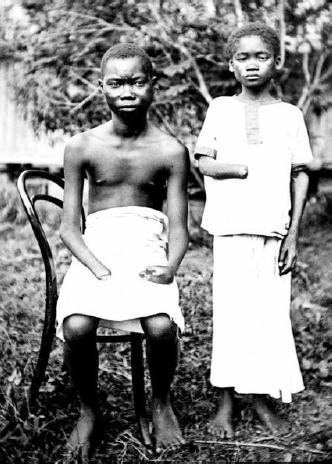
Figure 1.-- These child amputees were identified as Mola and Yoka. They are twi\o of the countless victims of atrocities committed in the Congo Free State. The photograph was taken about 1905. Source: Anti-Slavery International. |

|
The moto for the Congo Free State was 'Work and Progress'. It was in fact a far cry from the humanitarian inpulse with which the Victorians justified colonialism. No where in the colonized countries was this more painfully apparent than the Congo. Colonization in most European colonies meant an end to slvery. The CFS essentially insy\titutionlized slavery. Leopold administered the Congo as his personal property and not a national colony. The people in the the Congo Free State were essentilly turned into slaves laboring to enrich Leopold personally. They were subjected to horendous abuses, including enslavement, rape, and murder of innocents. Villiagers were given quota of rubber sap to gather in the forests. Failure to meet the quota which were often unrealisticallhigh could result in amputation. This included both children and adults. Villages which failed to collect the required quotas were required to pay the shortage in severed hands. The hands were collected by the soldiers of the Force Publique and sometimes by the villages themselves. Violence flared with villages attacked other villages to bbtain hands. Photographs of amputees began to circulte, including the child amputees (figure 1). The international campaign against King Leopold and the Congo Free State coincided with the improvement of photographic technology. The Kodak Brownie appeared (1900) ans similar cameras soon appeared. Thus mean that it was relatively easy to bring back photographic images from even the most isolated places on earth, such as the Congo.
And at the same time advances in photolithography made it possibe to publish photographs in magazines abd newspaper.
Congo atrocity photographs shocked the public with undeniaable depictions of Belgian brutality. The most prominent individuals taking such photographs were Alice Seeley Harris and John Harris, English missionaries who arrived at the Congo Balolo Mission in 1898. [Nault] The photograph here is on of hundreds of such imges (figure 1).
A particularly heart-wrenching photograp was taken by Alice Harris. It shows a man named Nsala of Wala gazing at the severed hand and foot of his 5-year-old daughter who had been murdered by sentries of the Anglo-Belgian India Rubber (ABIR) Company.
Mass-deaths and amputations in the CFS became an interntional cause célèbre. It became a griwing embarrassment to both the King and Belgium as the truth began to leak out. Belgium had been portrayed itself as a progressive colonil power and upholding human rights. The Congo Reform Movement was organized. Prominent individuals joined, including Joseph Conrad (Heart of Darkness, Arthur Conan Doyle (Crime of the Congo), Mark Twain (King Leopold's Soliloquy), Bertrand Russell, and Booker T. Washington. It was difficult for King Leopold to refute men with reputations like those associated wit the Congo Reform Movement.
Conrad, Joseph. Heart of Darkness. This is a novel, but proved extreneky influential.
Doyle, Arthur Conan. Crime of the Congo.
Nault, Derrick M. "At the bar of public sentiment: The Congo Free State controversy, atrocity takes, and human rights tales," Ascademia.edu.
Twain, Mark. King Leopold's Soliloquy),
Navigate the Children in History Website:
[Return to Main Congo Free State page]
[Return to Main Belgian Congo history page]
[Return to Main Belgian Congo/Zaire history page]
[Return to Main National Empires in Africa page]
[Return to Main Scramble for Africa page]
[Return to Main Belgian regional page]
[About Us]
[Introduction]
[Biographies]
[Chronology]
[Climatology]
[Clothing]
[Disease and Health]
[Economics]
[Freedom]
[Geography]
[History]
[Human Nature]
[Ideology]
[Law]
[Nationalism]
[Presidents]
[Religion]
[Royalty]
[Science]
[Social Class]
[Bibliographies]
[Contributions]
[FAQs]
[Glossaries]
[Images]
[Links]
[Registration]
[Tools]
[Children in History Home]
